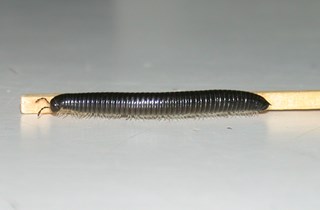Portuguese millipede
What does it look like?
What does it look like?
This millipede has a many-segmented, smooth cylindrical body ranging in colour from black/grey to light brown. When mature, they may be up to 45mm long with as many as 50 body segments, each with two pairs of legs. When disturbed, they commonly curl into a tight ball, or may thrash around trying to escape.
Portuguese millipedes in New Zealand
These insects were first found in 2021 in the Wellington region at what’s called a transitional facility. These facilities are authorised by the Ministry for Primary Industries to receive and clear imported goods into the country. Based on interviews with neighbouring businesses at the time, the millipedes appear to have been established in the area for at least 20 years. As these facilities receive goods and then distribute them across the country, it is expected that the Portuguese millipede is likely to be widespread throughout New Zealand.
Portuguese millipedes feed on decomposing organic matter such as leaf litter, decaying wood, and moss. In gardens they will commonly be found in and around compost bins, or areas where there is a thick layer of mulch or leaf litter, as these areas provide shelter, moisture, and food. Millipedes are also attracted to lights and are often found in well-mulched garden beds close to houses.
Why is it a problem?
Why are they a problem?
Portuguese millipedes are most active in autumn and early winter when they may gather in large numbers and become quite mobile. It is during this time of year that people most often notice them.
While they can be a nuisance, Portuguese millipedes pose no risk to human health, and are not known to have any negative effects on the environment.
However, particularly following periods of heavy rainfall in autumn and spring, they can invade homes and buildings in large numbers. If they are squashed, they can release a pungent yellow secretion which may stain carpets and clothing. They do not breed indoors and will usually die once inside.
Control Methods
What can I do about Portuguese millipedes?
While control options for millipedes are unfortunately limited, there are some options available to reduce millipede numbers.
We recommend:
- Reducing the amount of suitable habitat and sources of food around your house – for example keep compost and mulched areas as far away from your house as possible on your property.
- Installing smooth vertical barriers to prevent millipedes from entering the house. Millipedes cannot cross smooth vertical surfaces, such as plate glass, smooth vinyl, or polythene tape. These can be fixed in an upright position around the base of the house, below doorsteps or under window ledges. Any barrier should be continuous with no breaks (unless under doorways) and kept free of bridging vegetation. A moat system such as a 100mm C-Purlin buried flush with the ground can also be installed around dwellings, as millipedes will fall in and be unable to escape.
- Light traps can offer good control of Portuguese millipedes as they are attracted to lights. These can be set up along the outside wall where millipedes are entering. This wall can also be treated with an appropriate insecticide. Lights can also be set up in the garden to lure millipedes away from dwellings.
- Chemical sprays can be applied to ground surfaces and walls to eliminate any millipedes trying to enter buildings. These do, however, have a limited active life and must be re-applied for ongoing control. Please consult your local hardware store or pest control professional for specific advice on what chemical may be appropriate for your situation.
There is also information on this commercial website: https://www.yates.co.nz/problem-solver/pests/millipedes/







